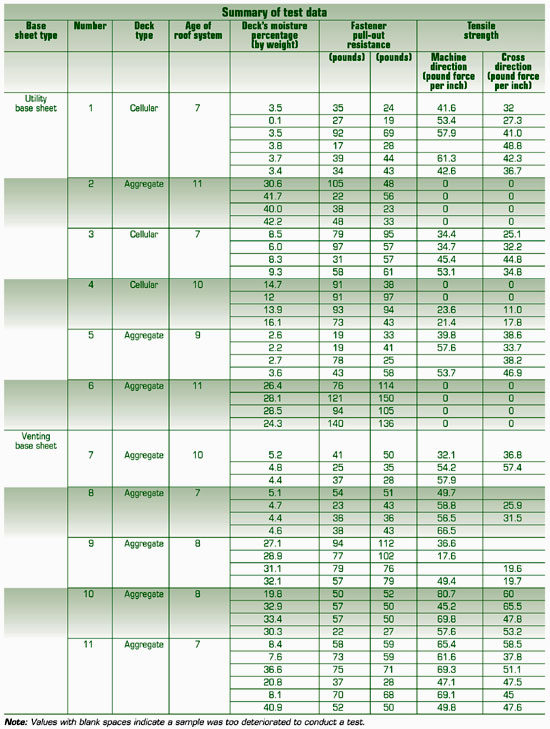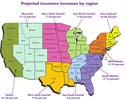For 35 years, roofing professionals have used asphalt base sheets as mechanically attached bases for roof systems. But roofing contractors, specifiers and consultants are faced with different types of lightweight insulating concrete decks, and the performance of base sheets over these decks has varied. When not performing properly, base sheets can contribute to roof system problems, including displacement from wind, wrinkling, splitting and ridging.
During summer 2002, Richard P. Canon, principal with Canon Consulting and Engineering Co. Inc., Spartansburg, S.C.; William J. Woodring, director of field technical operations for GAF Materials Corp., Wayne, N.J.; and I made an effort to document how base sheets perform by conducting extensive field sampling, laboratory testing and analysis. We sought to determine whether physical changes occur in the base sheets over time when installed over lightweight insulating concrete decks. Eleven roof systems were selected ranging in age from 7 years old to older than 10 years. The testing included determining decks' moisture contents and pH values; decks' fastener pull-out resistance strengths; physical condition of the base sheets and their respective roof systems; and tensile testing of base sheets' desaturated fiberglass mats. The results of this investigation were presented at the Roof Consultants Institute's Building Envelope Symposium in November 2002.
What did we find? The results, though not well-documented until this research, were not surprising: There is a significant difference in performance between a utility base sheet and venting base sheet when the moisture content of the lightweight insulating concrete deck is above 15 percent to 20 percent. That's the bottom line. Following is how we arrived at our conclusion.
Decks and base sheets
Lightweight insulating concrete decks can be categorized as two primary types: those made from perlite or vermiculite aggregate and those that use a foaming agent to entrap air in the concrete in lieu of lightweight aggregate. Both deck types typically are poured to a minimum 2-inch (51-mm) thickness and weigh between 20 pounds per cubic foot and 30 pounds per cubic foot (320 kg/m³ and 480 kg/m³). They may be poured incorporating rigid plastic insulation board stock. In addition to being structural decks, they also often provide insulating value for buildings and slope-to-drain for deck structures.
Bituminous roof systems over these decks most often use a mechanically attached base sheet as the base or foundation for either the attachment of insulation in hot asphalt or adhesive or for additional roofing plies (or modified bitumen sheets). This installation method has provided roof systems that have extensive fire-resistance and wind-performance ratings and a long record of performance in the field. The base sheet used for this application typically is either a utility base sheet, which is a fiberglass base sheet that meets ASTM D4601, "Standard Specification for Asphalt-Coated Glass Fiber Base Sheet Used in Roofing," and commonly is referred to as a No. 25 base sheet, or a fiberglass venting base sheet that meets ASTM D4897, "Standard Specification for Asphalt-Coated Glass-Fiber Venting Base Sheet Used in Roofing."
Figure 1 summarizes some property requirements of these base sheets and shows the significant differences between the two. For example, the venting base sheet, surfaced with mineral granules, typically is 21/2 times to three times heavier than a utility base sheet, and this weight primarily is found in the granules and additional coating asphalt on the fiberglass mat.

Figure 1: How utility and venting base sheets compare
Lightweight insulating concrete decks can have higher moisture contents than other poured decks, even after drying, to the point where no more water will leave the deck. This point is known as "equilibrium moisture content." Because of this moisture phenomenon, many manufacturers have recommended that only venting base sheets be used in bituminous roof system applications over lightweight insulating concrete decks. Yet because any mechanically attached base sheet will prevent the buildup of vapor pressure traditionally associated with blistering, many manufacturers have allowed utility base sheets over lightweight insulating concrete decks.
Decks composed of concrete typically have high pH levels (11.0 to 12.5). The performance of utility base sheets installed over a substrate with such a high pH level has not been without problems. This is because the fiberglass reinforcement used in base sheets can be seriously compromised when water contacts the coated fiberglass in a high-pH environment. Basically, the fiberglass mat loses its strength and ability to hold the roof system in place.
So what happens in the real world? Notice the underlying condition for problems is not solely the pH level of the deck, but add water or a moist environment, and experience has shown many of us utility base sheets do not perform as well as venting base sheets. However, roofing contractors and manufacturers, facing increasing price pressure for the cost of a roof system, have increasingly allowed the use of utility base sheets as the base plies in premium roof systems.
What was tested?
The investigation included built-up and modified bitumen roof systems located along the gulf coast of Alabama and panhandle of Florida and in Jacksonville, Fla. The study specifically limited the geographic area to avoid introducing other climates that could be considered "causes" to explain any differences in how the roof systems performed during several years.
A minimum of four test cuts were taken from each roof. From each test-cut location, a 12- by 12-inch (305- by 305-mm) sample of the roof system was removed and a companion 2-inch (51-mm) core of the lightweight insulating concrete deck was taken. Two fastener pull-out tests were conducted on the lightweight insulating concrete deck before making the test-cut repair.
Because base sheet degradation caused by an alkaline environment (high pH) typically is marked by a loss of strength in the fiberglass mat reinforcement, testing of the roof cuts was done by first separating the base ply from the remaining plies in the roof membrane and then removing all the asphalt from the reinforcement of the base ply through desaturation. The desaturated fiberglass mat then was tested for machine direction and cross direction tensile strength at room temperature.
The analysis of the roof decks included the pull-out strength testing values, moisture contents and measurement of the decks' pH levels. The pH measurements ranged from 11.6 to 12.4. The decks' moisture contents were measured by calculating the weight differences in the lightweight insulating concrete samples before and after 5 1/2 hours of conditioning at 219 F (104 C). Figure 2 shows the fastener pull-out values compared with deck moisture content, machine direction tensile strength and cross direction tensile strength.

Figure 2: A summary of the test data collected comparing utility and venting base sheets
What did the data show?
There was a significant amount of information collected from the 11 roof systems, and the following observations were made:
- The use of utility base sheets mechanically attached to lightweight insulating concrete decks may be acceptable provided the lightweight substrate has an equilibrium moisture content as reflected in the manufacturer's published literature.
- The data collected show a significant performance difference between utility base sheets and venting base sheets when the moisture content of the lightweight insulating concrete is more than 15 percent to 20 percent.
- There does not appear to be a difference in base sheet tensile strength performance when the moisture content of the lightweight insulating concrete is less than 10 percent.
- There was not a correlation between fastener pull-out values and the decks' moisture contents.
- There does not appear to be a difference in performance of utility base sheets when installed on either lightweight aggregate or cellular lightweight insulating concrete.
What does it mean?
Our investigation into the performance of base sheets mechanically attached to lightweight insulating concrete decks provides data to accompany the experience of roofing professionals. In terms of what to do with the results, consider the following recommendations to make sure you offer roof systems that have the best science behind their performance:
- When the moisture content of a lightweight insulating concrete deck is greater than 10 percent, use a venting base sheet or other product with a proven track record of resistance to the effects of a high-alkaline (high-pH) environment in the presence of moisture.
- A deck's condition and moisture content at the time of roof system installation are important parameters in determining roof system options. On reroofing projects, always measure a deck's moisture content before determining which base sheet to use.
- Do not install utility base sheets where there is no underside venting provided. Use a venting base sheet or alternative product.
- Because of the inability to determine a roof deck's final moisture content, do not install utility base sheets on new construction projects where an extended length of service is required. Use a venting base sheet or alternative product instead.
Next steps
Because the number of roof systems in the study was limited as a result of access and time constraints, the results should be used as a base line that can be confirmed through additional investigation. This study also provides an opportunity for manufacturers to develop alternative products to utility base sheets that will perform when a deck has a higher moisture content.
There are two challenges to this opportunity: for manufacturers to develop a product that will perform for a long time while offering an economic benefit to the building owner and for the industry to develop a method of predicting this performance in the short term.
Helene Hardy Pierce is director of contractor services for GAF Materials Corp., Wayne, N.J.

